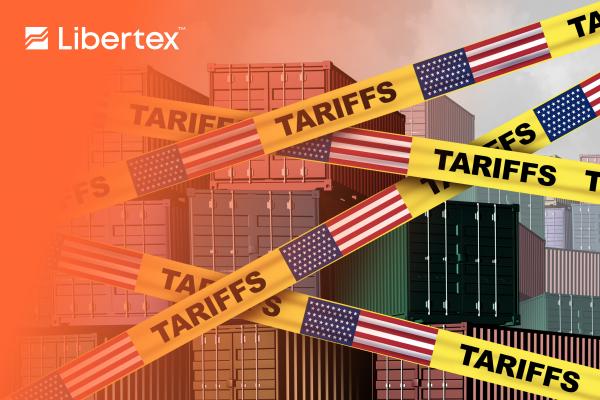Say what you will about the new White House, but everyone can surely agree that Trump's first financial quarter in office has been anything but uneventful. A constant enigma, the US President has cast himself simultaneously as both peacemaker and trade warrior, stirring up global markets in the process. His wide-reaching tariffs on aluminium and steel imports coupled with targeted levies on Chinese, Canadian and Mexican goods have led to increased uncertainty for US equities, as investors are unable to gauge the full impact of the Republicans' economic policies on corporate America's bottom line. Both the Nasdaq 100 and S&P 500 have declined since Trump's inauguration, losing 5.03% and 2.61%, respectively, year to date as of 26 March 2025.
Now, The Donald's 2 April deadline looms, and it looks like things could be set to get worse before they get better. Liberation Day, as it has been dubbed, will see an end to the moratorium on 25% tariffs on Canadian and Mexican imports, while the already 20% tariff on Chinese goods could be extended and sanctions placed on any country that buys Venezuelan oil. It's even possible that hitherto close partners like the EU, Australia, Brazil, Japan and South Korea could be targeted. But what most investors are wondering is how this will all affect the share prices of American companies that rely on tariff-free trade with these nations. In this article, we'll explore two main scenarios.
Driving up prices
Despite what President Trump might have first thought, the introduction of hefty tariffs on imports into the US makes those often crucial goods more expensive to Americans, including manufacturers and other businesses. One of the sectors most impacted by the new 25% tariffs on near neighbours Mexico and Canada, as well as the global commodity levies already imposed, will be the highly competitive automotive industry. With much of the production of even major US brands like Ford, Chevrolet and Dodge taking place in Mexico, this will surely weigh on stock prices in the medium term. The proposed introduction of reciprocal tariffs on all countries has been somewhat walked back, with Trump clarifying that he will likely be "more lenient than reciprocal". This has been confirmed to mean that non-tariff barriers such as VAT will not be considered when calculating retaliatory tariffs.
However, consumer and corporate sentiment has already taken a hit, as the Conference Board noted that its measure for consumer expectations on business, income and labour has dropped to a 12-year low. The main reason for this is the uncertainty about who and what will be affected. For instance, if levies are placed on goods from Japan and Korea, this would have a devastating impact on several tech and consumer goods producers that use parts and finished products from these countries. As in most cases, it will be the end customer who will suffer the most, but unfortunately for many corporations, this will simply mean that sales will be depressed as cash-strapped consumers reduce discretionary spending to a minimum. There will also likely be a knock-on effect on inflows into the stock market as a result of lower disposable income among retail investors should the trade war be as sustained and brutal as some have suggested.
Method to the madness
It's often said that we should watch what Trump does and not what he says. He frequently uses bombastic rhetoric to scare his international colleagues and bring people to the negotiating table. Indeed, his recent comments about "leniency" and "possible exceptions" would suggest that Trump would prefer to hammer out a deal to avoid the imposition of a new round of tariffs that will hurt American businesses and consumers at least as badly as the intended targets. In fact, Treasury Secretary Scott Bessent even went as far as to outright state last week that countries can pre-negotiate with the US or remove their own tariffs voluntarily to avoid facing the new reciprocal tariffs on 2 April. Indian Prime Minister Narendra Modi met Trump last month to try and get ahead of the curve, with the two nations agreeing to resolve tariff rows and work on the first tranche of a deal by Q3 2025 in the ultimate pursuit of two-way trade of $500 billion by 2030.
Meanwhile, the strategy for the automotive industry is bifold. Certainly, Trump would like to negotiate even better trading terms between the US and its neighbours to the North and South. However, he is also incentivising car manufacturers to bring production back to the US and stimulate the economies of former powerhouse states like Michigan, Ohio, Tennessee, and Alabama. In the long run, this could help to make Americans quantitatively more wealthy and easily offset the increased costs of production. If a mutually beneficial deal can be reached with China, this will set both countries and the world on a path towards prosperity that will lift up both equities prices and local standards of living. That said, it is worth noting that the competition between cheap Chinese EVs and the new class of American-made vehicles is likely to be so intense that Trump will be forced to levy some sort of tariff on such imports to keep domestic cars like Teslas competitive.
Trade US stocks and more CFDs with Libertex
With Libertex, you can choose from a wide variety of CFDs on everything from stocks, commodities, and ETFs to indices, forex and crypto. Libertex's wide CFD offering includes major world indices such as the S&P 500, Nasdaq 100, and EURO STOXX 50, as well as individual stocks like Ford, Tesla and Nvidia. For more information or to create an account of your own, visit www.libertex.com/signup today!


